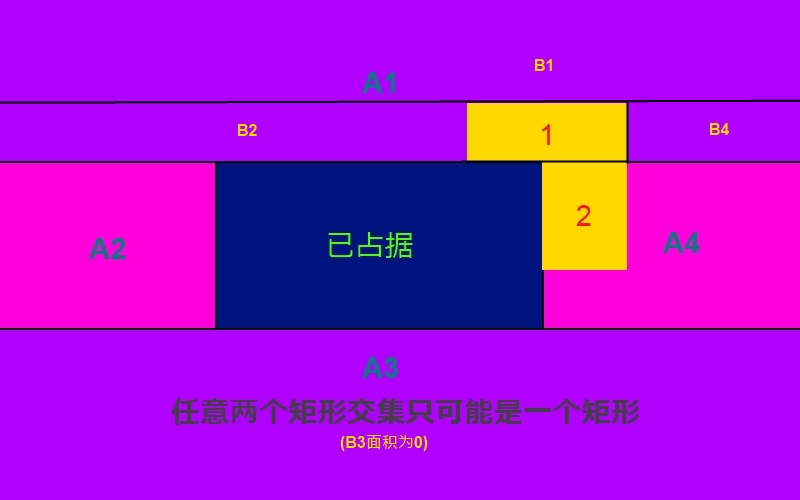题目解答
刚一读题,第一反应就是朴素染色,但是因为较大的数据,染色法绝对行不通。因为我们没有必要重复覆盖某个点,包括计算面积我们不需要统计,而是直接用坐标计算。所以可以考虑使用面向矩形整体的方法:
- 二维线段树或者离散化 + 线段树:这种方法的弊端是要么过于复杂,要么MLE,所以牛刀还是用来屠牛吧
- 我具体论述一下矩形切割:首先通过分析我们知道凡是在后面覆盖过的绝对不会被前面的覆盖,因此假设我们覆盖第N个矩形,那么第(N-1)个一定在它的下面,由此知道要倒序染色(1),这样可以省去很多的操作;而两个矩形相交如何处理呢?我们知道:如果两个矩形相交,他们的交集必定是一个矩形,记录一个矩形只需两个对角坐标,处理方便,所以我们要对每次的覆盖进行切割(2);

如图:中心深蓝色的表示当前已经覆盖的矩形,他的相邻四个A1,A2,A3,A4则是去掉已占据部分后被分割的四个矩形,也就是说凡是去掉交集都可把剩余的(未染色)部分切割成4个新矩形,包括面积为0的矩形。图中黄色的为待占据矩形,因为是倒序染色,所以忽略与已占据部分的交集,也就是说我们只需考虑未染色的部分(3),记录未染色部分,并与未染色部分进行覆盖判断,因此黄色的与A1部分交集是 1,覆盖后,A部分又可以划分为4个新的矩形B1,B2,B3,B4(B3的面积为0),可以看出整体是一个分治策略(4)。
综合以上(1)(2)(3)(4)条,我们对未染色部分进行处理,根据这种思路,可以不用递归,加一个链表记录所有的新的矩形,牺牲空间换取时间,平均时间复杂度O(n^2)。可以秒出。
运行结果
Compiling…
Compile: OK
Executing…
Test 1: TEST OK [0.000 secs, 2956 KB]
Test 2: TEST OK [0.000 secs, 2956 KB]
Test 3: TEST OK [0.011 secs, 2956 KB]
Test 4: TEST OK [0.000 secs, 2956 KB]
Test 5: TEST OK [0.011 secs, 2956 KB]
Test 6: TEST OK [0.000 secs, 2956 KB]
Test 7: TEST OK [0.011 secs, 2956 KB]
Test 8: TEST OK [0.011 secs, 2956 KB]
Test 9: TEST OK [0.000 secs, 2956 KB]
Test 10: TEST OK [0.011 secs, 2956 KB]
Test 11: TEST OK [0.011 secs, 2956 KB]
All tests OK.
Your program (‘rect1’) produced all correct answers! This is your
submission #2 for this problem. Congratulations! //坐标确实是本题令我头疼的地方 .
程序
1 |
|
后记
本文是百度空间的移植,附:全部USACO题目解答。